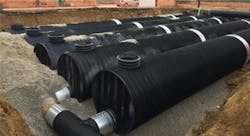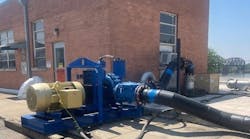At the turn of the 20th century, the City of Portsmouth, Ohio, constructed a nearly 2.5-mile brick tunnel sewer from the Ohio River through the hilltops of the city to enclose Lawson Run Creek. The tunnel ranged in size from 144-in. diameter sewer near the river (at the present wastewater treatment plant) to a 48-in. diameter sewer in its far upstream reach at the north end of the city.
As the city grew, residential development spread upward and outward from the river, filling in the once-wooded areas at the headwaters of Lawson Run. These homes tied their sanitary sewers into the Lawson Run sewer, making it a combined sewer. By the 1950s, neighborhoods in the Grandview Avenue area experienced overland flooding from the development in the upper reaches of the system. To alleviate this flooding, a parallel sewer was added, but because of the steep surrounding slopes and continued development, overland flooding by the combined sewer continued.
To comply with an Administrative Consent Order issued by U.S. Environmental Protection Agency, city officials paired an underground storage facility with sewer separation efforts on the 2300 block of Grandview Avenue. The project separates the upstream reaches of the Lawson Run sewer, helps control overland flooding and reduces the number and volume of combined sewer overflows into the Ohio River.
Construction of the sewer separation and underground storage facility began in the fall of 2014. The storage facility consists of eight 104-ft rows of 108-in.-diameter DuroMaxx steel-reinforced polyethylene (SRPE) pipe, with each row connected by a 36-in. SRPE manifold supplied by Contech Engineered Solutions. Use of Contech’s DuroMaxx pipe provided a lightweight, cost-effective solution to maximizing storage volume on a tight site.
The underground storage facility serves as a detention facility that gradually fills as the hydraulic grade line in the existing Lawson Run sewer rises. A stainless steel orifice plate at the downstream end of the facility controls the release of the stored combined sewage back into the system. Use of the orifice plate enables flows in the existing Lawson Run sewer to draw down over a longer period of time, thus providing the wastewater treatment plant with more time to capture and treat the wet weather flows. Construction of the combined sewer storage facility was completed and the facility was put into service in early 2015.



